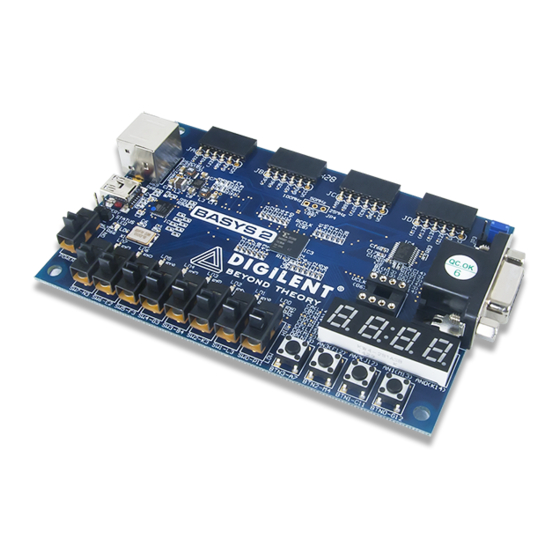Digilent Basys 2 Manuel de référence - Page 9
Parcourez en ligne ou téléchargez le pdf Manuel de référence pour {nom_de_la_catégorie} Digilent Basys 2. Digilent Basys 2 12 pages. Fpga board

Basys2™ FPGA Board Reference Manual
Information is only displayed when the beam is moving in the "forward" direction (left to right and top to bottom),
and not during the time the beam is reset back to the left or top edge of the display. Much of the potential display
time is therefore lost in "blanking" periods when the beam is reset and stabilized to begin a new horizontal or
vertical display pass. The size of the beams, the frequency at which the beam can be traced across the display, and
the frequency at which the electron beam can be modulated determine the display resolution. Modern VGA
displays can accommodate different
resolutions, and a VGA controller circuit
dictates the resolution by producing timing
signals to control the raster patterns. The
controller must produce synchronizing pulses
at 3.3V (or 5V) to set the frequency at which
current flows through the deflection coils, and
it must ensure that video data is applied to
the electron guns at the correct time. Raster
video displays define a number of "rows" that
corresponds to the number of horizontal
passes the cathode makes over the display
area, and a number of "columns" that
corresponds to an area on each row that is
assigned to one "picture element" or pixel.
Typical displays use from 240 to 1200 rows
and from 320 to 1600 columns. The overall
size of a display and the number of rows and
columns determines the size of each pixel.
Video data typically comes from a video
refresh memory, with one or more bytes
assigned to each pixel location (the Basys 2
uses three bits per pixel). The controller must
index into video memory as the beams move
across the display, and retrieve and apply
video data to the display at precisely the time
the electron beam is moving across a given pixel.
A VGA controller circuit must generate the HS and VS
timings signals and coordinate the delivery of video
data based on the pixel clock. The pixel clock defines
the time available to display one pixel of
information. The VS signal defines the "refresh"
frequency of the display, or the frequency at which
all information on the display is redrawn. The
minimum refresh frequency is a function of the
display's phosphor and electron beam intensity, with
practical refresh frequencies falling in the 50Hz to
120Hz range. The number of lines to be displayed at
a given refresh frequency defines the horizontal
"retrace" frequency. For a 640-pixel by 480-row
display using a 25MHz pixel clock and 60 +/-1Hz
refresh, the signal timings shown in the table at right
Copyright Digilent, Inc. All rights reserved.
Other product and company names mentioned may be trademarks of their respective owners.
pixel 0,0
640 pixels per row are displayed
during forward beam trace
Display Surface
pixel 479,0
Stable current ramp - information
is displayed during this time
Current
waveform
through
horizontal
defletion
coil
HS
"front porch"
Figure 15. VGA system signals.
T
fp
T
pw
Symbol Parameter
T S
Sync pulse
T disp
Display time
T pw
Pulse width
T fp
Front porch
T bp
Back porch
Figure 16. VGA system timings for 640x480 display
pixel 0,639
pixel 479,639
Total horizontal time
Horizontal display time
Horizontal sync signal
sets retrace frequency
T
S
T
disp
T
bp
Horiz. Sync
Vertical Sync
Time
Clocks Lines
Time
16.7ms
416,800
521
32 us
15.36ms
384,000
480
25.6 us
64 us
1,600
2
3.84 us
320 us
8,000
10
640 ns
928 us
23,200
29
1.92 us
Page 9 of 12
Retrace - no
information
displayed
during this
time
retrace
time
time
"back porch"
Clks
800
640
96
16
48
